
- Hajji Nawab Hafiz Muhammad Nasrullah Khan Sahib, Wali Ahad Bahadur (1876-1924)
- Sikander Jah, Nawabzada Muhammad Habibullah Khan Bahadur (1903-1930)
- Nawabzada Muhammad Rafiqullah Khan (1905-1942)
- Hajji Nawab Hafiz Muhammad Ubaidullah Khan Sahib Bahadur (1878-1924)
- Yamin ul-Mulk, Imad ud-Daula, Nawabzada Muhammad Rashid uz-Zafar Khan Bahadur (1907-1961) - see III

- Suraya Jah, Nawab Gowhar-i-Taj, Abida Sultan Begum Sahiba (1913-2002) - see II

- Qamar-i-Taj, Taj Dulhan, Nawabzadi Rabia Sultan Begum Sahiba (1916-2000)
- Hajji Nawab Hafiz Muhammad Nasrullah Khan Sahib, Wali Ahad Bahadur (1876-1924)
History
The house of Bhopal descends from Dost Mohammad Khan, an Afghan adventurer and cunning intriguer, who belonged to the Mirzai (or Mirazi) sept of the Orakzai (Warakzai) clan of Tirah, an area which today straddles the Af-Pak border. Born around 1672, Dost Mohammad left home as a teenager to seek a living in India. He took service first under Jalal Khan, a noble who belonged to his own Afghan tribe, and later directly under the emperor Aurangzeb. By 1705, when Aurangzeb was in the last years of his very long life, and disorder was already rife, Dost Mohammad (now in his 30s) took service under the Hindu Raja of Sitamau and served as the Mukhtar (guardian) of the infant Thakur of Mangalgarh, whose widowed mother was regent. Aurangzeb died in 1707, and several decades of anarchy ensued. During this time, Dost Mohammad played a constant game of intrigue and cunning, leveraged the motley forces available to him from Sitamau and Mangalgarh, used kinship ties within the Afghan community, plundered the coffers of his infant ward, betrayed all his former patrons by turn, seized territories from them and from the Mughal heirs of Aurangzeb, and somehow managed to carve out the sizable principality of Bhopal for himself. He declared independence in 1723, an act of hubris or recklessness which raised the heckles of Asaf Jah I (later the first Nizam of Hyderabad), who had been on the other side of intrigues at the Mughal court. Dost Mohammad had sided with the Sayyid brothers, who were upstarts like himself, while the Nizam had been against their usurpation of power. As early as 1724, the Nizam invaded Bhopal, and Dost Mohammad proved no match for him; after all, this was real war, rather than skirmishes laced with intrigue and back-stabbing. Dost Mohammad was forced to cede Islamnagar and a very big chunk of his territory, pay one million rupees (10 lakhs) in cash, and serve as the Nizam's Qiledar or fort governor, thus becoming a vassal of the Nizam. He also had to surrender his eldest son as a hostage.
Dost Mohammad died four years later, in 1728. He had fathered six sons and several daughters by various wives and concubines, and his descendants were abundant of number, but not of ability. The state faced frequent attack from its neighbours, in particular the Marathas, but the ruling family was both incompetent and racked by internecine conflict among the descendants of Dost Mohammad's two eldest sons. The root cause of discord was the fact that the eldest son was illegitimate, and the eldest legitimate son was a minor when his father died. In 1724, Dost Mohammad had given his eldest (but illegitimate) 15-year-old son, Yar Mohammad, as a hostage to the Nizam of Hyderabad. Dost Mohammad died in 1728, the Nizam invested his hostage with the insignia of royalty and sent him back to his homeland (Bhopal) to make good his claim on the throne. With the help of the army loaned to him by the Nizam, Yar Mohammad gained control of the state; expand this and talk of Yar Mohammad's wife and widow Maaji Sahib Mamola Bai (a Rajput convert) and her two step-sons (two sons of Yar Mohammad), her adopted son Chhotey Khan (a Brahmin convert) and how Mamola and Chhotey administered the state effectively and rather well. Chhotey Khan died in 1794 and Mamola Bai died in 1795 aged around 80.
By 1795, Bhopal had lost much of its power and territory. In that year (1795), Bhopal was again faced by an existential threat from the Marathas, and the ruling Nawab, Hayat Mohammad, was able to defend the state only by importuning the intervention of his distant but agnatic cousin, Wazir Mohammad, who was the grandson of Dost Mohammad's fourth son, and who was holding a high position in the army of the Nizam of Hyderabad at that time. With his help, the Marathas were fended off with great difficulty, but the matter did not end there. Wazir Mohammad chose to resign from the service of the Nizam and settle in his native Bhopal as minister and advisor to his royal kinsman.
Hayat Mohammad died twelve years later, in December 1807, and was succeeded by his indolent son, Ghaus Mohammad, whose mother had been Hayat Mohammad's favorite dancing-girl. Within a matter of months, Ghaus Mohammad had lost battle to the Maharaja Scindia of Gwalior, yielded valuable territory to him, accepted him as overlord, and agreed to pay an annual tribute of Rs. 50,000 to the Gwalior durbar. After all this had transpires, minister Wazir Mohammad came to an agreement with Nawab Ghaus Mohammad. While the Nawab would remain Nawab all his life, receiving every mark of honour and public deference, as also a generous allowance, he would make no intervention in affairs of state. He would live in retirement at Raisen outside Bhopal, and the administration would be run by Wazir Mohammad, who was named Nawab Regent. This agreement was reached in November 1808, and Ghaus Mohammad duly retired to Raisen, where he would indeed spend his remaining years quietly. By the time he died in 1826, he would be the father of fifty-six children, borne mostly by concubines and dancing-girls.
In 1816, eight years after talking over the administration, Regent Wazir Mohammad died. He was succeeded as Regent by his second son, Naseer Mohammad (b. 1793), the elder son having been set aside because he had quarreled with his father. Naseer Mohammad, whose mother was a Hindu Rajput lady, was a cultured and well-mannered young man, and he won the goodwill of Nawab Ghaus Mohammad by virtue of polite attentions, deference and good manners. Refined as he was, the new regent had neither experience of battle nor taste for it; there was thus much in common between Nawab and regent. Between them, they quickly agreed upon accepting the treaty of subsidiary alliance which the British were pressing upon all the rulers of India at that time. In February 1818, Ghaus Mohammad bestowed one of his better-born daughters, Qudsia (b. 1801), in marriage upon the youthful Regent. Exactly at this time, in fact only two days before the wedding, the Bhopal court entered into subsidiary alliance with the H'ble East India Company (HEIC), thereby becoming a protectorate of that company of tradesmen. As part of the agreement with the HEIC, signed in February 1818, significant territory which had earlier been lost to Scindia was restored to Bhopal. A period of general settlement, of external peace and internal concord between Nawab and his regent son-in-law, was inaugurated. It lasted less than two years. On 11 November 1819, regent Naseer Mohammad was killed in a shooting accident, aged only 26. He was survived by his wife, the 18-year-old Qudsia, and by an infant daughter, Sikandar. Qudsia was pregnant with a second child at that time, but she miscarried upon hearing of her husband's death.
The Bhopal Succession Case, 1926
From the early 19th century, the rulers of Bhopal had been female and in the direct line from the founder of the Afghan Pathan Orakzai dynasty, Dost Muhammad Khan. In 1868, at the coronation of the second Nawab Begum, Shah Jehan, her sole surviving daughter, Sultan Kaikhusrau Jahan Begum, was recognised by the British government as the heir apparent (rather than as heiress presumptive). This was unprecedented, because it meant that even if her mother gave birth to a son later, he would not get the throne; the existing daughter would supersede her brother. This had been done for a reason: Nawab Shah Jehan Begum had recently taken a second husband (after the death of Kaikhusrau's father); that second husband was a man of low birth, uncouth manners and corrupt habits. Also, he did not belong to the Mirzai Khel dynasty to which all preceding rulers of Bhopal (including women rulers) had belonged by birth. The idea that a son of such a man may one day sit on the throne of Bhopal was anathema to the nobility of Bhopal, as also to the British, and therefore they had taken the precaution of naming the Begum's only child by her first marriage, her daughter Kaikhushrau, as the heir apparent. In other words, the Begum's second marriage had been rendered effectively morganatic. It happened that the Begums's second marriage did not produce a living child, and so the inherent infirmity of the arrangement was never tested. Following the death of Nawab Shah Jehan Begum in 1901, her only surviving child, her daughter Kaikhusrau Jahan ascended the throne as Nawab Begum of Bhopal.[ citation needed ]
In 1874, Nawab Sultan Kaikhusrau Jahan married a distant cousin, Nawab Ahmad ‘Ali Khan Bahadur (1854-1902), a member of a senior branch of the dynasty to which Dost Muhammad had belonged, namely the Mirzai Khel dynasty. Upon her marriage, Kaikhusrau Jahan became a member of that dynasty, which by birth she was not, because her father had not been a Mirzai Khel dynast. The marriage ensured that the same dynasty would continue in the male line. The couple had three sons, Muhammad Nasrullah Khan (1876-1924), Muhammad Ubaidullah Khan (1878-1924) and Muhammad Hamidullah Khan (1894-1960).[ citation needed ] In 1902, the two elder sons married the daughters of Chanda Begum, their father's only sister, whose husband belonged to the Jalalabadi family, a prominent noble family of Bhopal state. Later, the third son, Hamidullah Khan, married an Afghan princess, Maimoona Sultan. Unfortunately, both of the elder sons died 1924, Ubaidullah from cancer in March that year, and Nasrullah from advanced diabetes in September. [2] Both of them left legitimate male heirs, and by the principle of primogeniture which prevailed in almost every Indian state, the logical heir presumptive to the throne would have been Nasrullah's elder son Muhammad Habibullah Khan (1903-1930). [3]
However, the Nawab Begum of Bhopal had other ideas, which were probably put into her head by her only surviving son, Hamidullah. In 1925, Sultan Kaikhusrau Jahan formally requested the Viceroy's Executive Council to recognise Hamidullah Khan as the heir apparent, in preference to her senior grandson, Habibullah Khan. She provided five reasons, including the following: firstly, that as the ruler, she had the right to nominate her successor; secondly, that Hamidullah Khan was more experienced and better educated than his nephew; thirdly, that Islamic law favoured surviving sons over any grandsons. Her main substantive argument was that the Islamic system of succession, where the throne passed from brother to brother, and therefore surviving sons were preferred over grandsons (see Rota system and the system of succession in the Saudi royal family) should apply to Bhopal. Supported by the Jalalabadi family, Habibullah filed a counter-claim, saying that there was no precedent for applying Islamic principles to succession in Bhopal and pointing out that the laws of primogeniture which had been prevalent since time immemorial in most Indian states, whether Hindu or Muslim, and certainly since the inception of British rule. [3]
After studying the facts of the case, the Viceroy's legal advisors rejected the Begum's request on 21 May 1925, averring that Islamic system of succession had never been applied in Bhopal. [3] Undeterred, Sultan Kaikhusrau Jahan appealed the matter to the India Office in London, then headed by the distinguished advocate Lord Birkenhead. Additional research conducted by the India Office found some support for Sultan Kaikhusrau Jahan's position. It was determined that under a 1772 decree issued by Warren Hastings, all civil legal proceedings for Muslims were to be dealt with according to Islamic law; this included succession to titles and properties. Several precedents existed, including one concerning the succession of Akbar Shah II to the Mughal throne in 1804, where the succession had been justified by citing the same Islamic rules of succession which the Nawab Begum was now invoking. [4]
Thus, the British authorities agreed that Hamidullah Khan would succeed his mother, if he survived her. This decision by the India Office did not, however, mean that the succession was secured to the progeny of Hamidullah Khan alone. On 7 May 1926, the Viceroy of India informed the Nawab Begum that if Hamidullah Khan predeceased her, the succession would pass to the line of her senior surviving grandson in preference to the children of Hamidullah Khan. This was strictly as per the same principles of Islamic succession which the Nawab Begum herself had strenuously insisted upon. However, the Begum was alarmed because it was entirely possible that her third son would die young, just as her two elder sons had died. She wanted earnestly to ensure that the succession passed only to her third son and then his progeny. There was only one way of ensuring this: she should abdicate and make him the ruler immediately. On 14 May 1926, Sultan Kaikhusrau Jahan abdicated in favour of Hamidullah Khan. The new Nawab of Bhopal formally informed the Viceroy and his council that his eldest daughter, Abida Sultan Begum, would succeed him unless he bore a male heir at a later date, in which case his son would succeed to the throne. The Government of India accepted his declaration, deciding the issue for the time being. Thus, Hamidullah Khan ascended the throne of Bhopal during the lifetime of his mother, and ensured that his own children would succeed him, rather than the progeny of his two older brothers.
The eldest son of the Nawab Kaikhusrau Jahan Begum, namely Nasrullah Khan, had left three children as his heirs when he died in 1924. All three of them, including the unfortunate Habibullah Khan, died without leaving any children of their own. The second son of the Nawab Begum, Ubaidullah Khan, had issue three surviving sons. His eldest son died childless and the second son had only one daughter, who embraced the Hindu religion and married an army officer. It was the third son of Ubaidullah Khan, namely Rashid Khan, who remains as a putative claimant to the throne of Bhopal. If Nawab Kaikhusrau Jahan had not changed the succession, it is Rashid Khan and his sons who would have inherited the throne of Bhopal. That family today runs the Jahan Numa hotel in Bhopal and the Reni Pani jungle lodge in the nearby forests.
Afterwards
Nawab Hamidullah Khan ruled Bhopal until acceding to the Union of India in May 1949. In 1928, he had designated his eldest daughter, Abida Sultan, as heir apparent; she, however, chose to emigrate to Pakistan in 1948, following which Nawab Hamidullah designated his second daughter Sajida Sultan, the Begum of Pataudi, as the new heiress to the throne of Bhopal. [5] The state of Bhopal became a constituent part of Madhya Pradesh in November 1956, and the former Nawab died in Bhopal in February 1960. Following his death, his decision to designate Sajida Sultan as heiress apparent was immediately contested by two other branches of the family before the Indian government formally recognised the claim of Sajida Sultan in January 1961, with retroactive effect. Sajida Sultan was recognised by the Indian government as the last Nawab Begum of Bhopal from her accession in 1960 until 1971, when the government formally derecognised the Indian princely houses. She died in 1995, upon which her only son Mansur Ali Khan, the Nawab of Pataudi, succeeded to the headship of the dynasty and was crowned as the titular Nawab of Bhopal. His maternal aunts Abida Sultan and Rabia Sultan, however, challenged his right to inherit the family properties and filed two civil suits in the Madhya Pradesh High Court in attempts to challenge his "coronation." Other members of the extended family also filed their own claims to various properties in Bhopal, resulting in several ongoing disputes. [5] In 2000, the Bhopal district court issued a ruling which affirmed the Government of India's previous recognition of Sajida Sultan as Nawab Begum of Bhopal over her elder sister Abida Sultan. Abida Sultan herself died in Pakistan two years later, but her son and heir Shahryar Khan declined to assert any claims to the family headship or to any properties in Bhopal. [5]
Following the 1965 Indo-Pakistan War, the 1968 Enemy Property Act gave the central government the right to appropriate Indian properties held by Pakistan nationals. After Nawab Mansur Ali Khan Pataudi died in 2011, his son Saif Ali Khan Pataudi was crowned as the titular Nawab of Pataudi in succession to his father, but he did not formally assume the headship of the erstwhile Bhopal ruling house or hold an investiture ceremony in Bhopal. The office of the Custodian of Enemy Property for India (CEPI) did however issue Saif Ali Khan a notice in December 2014 which recognised him as the successor to the Bhopal estates since his father's death. As of May 2015, the legal process to verify Saif Ali Khan Pataudi's inheritance rights remained an ongoing one. [5]
Claimants to the throne and their descendants
I. Claim of Sajida Sultan Begum (1915-1995)


- Nawabzadi Saleha Sultan Begum Sahiba (born 1940) m. Nawab Muhammad Bashir ud-din Khan Bahadur (born 1931)
- Nawabzada Mohamed Aamer bin Jung (born 1959), m. Zeba Begum Sahiba (born 1961)
- Sahibzada Mohammad ‘Abdu’llah Sahir bin Jung (born 1984)
- Sahibzadi Esra Sahar Jung (born 1987)
- Nawabzada Muhammad Sa’ad Bin Jung (born 1960), m. Asma Sangeeta Mankani Begum Sahiba
- Sahibzada ‘Ali Sha’az Jung (born 1988)
- Sahibzadi Zohar Jung (born 1990)
- Nawabzada Muhammad Omer Bin Jung (born 1968), m. Anjum Begum Sahiba (born 1968)
- Sahibzadi Zara Jung (born 1999)
- Sahibzada Ayaan Jung (born 2004)
- Nawabzada Muhammad Fateh Faiz Bin Jung (born 1974)
- Nawabzada Mohamed Aamer bin Jung (born 1959), m. Zeba Begum Sahiba (born 1961)
- Muhammad Mansur ‘Ali Khan Bahadur, Nawab of Pataudi, Head of the Royal House of Bhopal (1941-2011), m. Nawab Ayesha Sultan Begum Sahiba (Sharmila Tagore) (born 1946)
- Muhammad Saif Ali Khan Bahadur, Nawab of Pataudi, Head of the Royal House of Bhopal (born 1970), m. (1, 1991-divorced 2004), Amrita Virk [Begum Saif ‘Ali Khan] (born 1958), (2, 2012–present). Kareena Kapoor (born 1980)
- (1). Nawabzada Ibrahim ‘Ali Khan (born 2001, of Amrita)
- (2) Nawabzada Taimur Ali Khan (born 2016, of Kareena) [6]
- (3). Nawabzadi Sarah Begum Sahiba (born 1994, of Amrita)
- (4). Nawabzadi Saba Sultan Begum Sahiba (born 1975)
- (5). Nawabzadi Soha Sultan Begum Sahiba (born 1978), m. Kunal Sharik Khemu (born 1983)
- Muhammad Saif Ali Khan Bahadur, Nawab of Pataudi, Head of the Royal House of Bhopal (born 1970), m. (1, 1991-divorced 2004), Amrita Virk [Begum Saif ‘Ali Khan] (born 1958), (2, 2012–present). Kareena Kapoor (born 1980)
- Nawabzadi Sabiha Sultan Begum Sahiba (born 1942), m. Sahibzada Mir Arjumand ‘Ali Khan (born 1940)
- Sahibzadi Zia Sultan Begum Sahiba (born 1965), m. Syed Kamal Fareed
- Rabia Fareed (born 1989)
- Nadia Fareed (born 1995)
- Sahibzadi Samia Sultan Begum Sahiba (born 1966), m. Christopher Hartnett
- Imaan Hartnett (born 1995)
- Zara Hartnett (born 1999)
- Sahibzadi Zia Sultan Begum Sahiba (born 1965), m. Syed Kamal Fareed
- Nawabzadi Qudsia Sultan Begum Sahiba (1946-1989), m. Mian Ghulam Fariduddin Riaz (born 1939)
- Iftikharuddin Riaz
- Sara Sultan Begum (born 1970), m. Sahibzada Faiz Muhammad Khan (born 1959; see II)
- Sahibzadi Aaliya Sultan Begum (born 1994)
- Nawabzadi Saleha Sultan Begum Sahiba (born 1940) m. Nawab Muhammad Bashir ud-din Khan Bahadur (born 1931)
II. Claim of Abida Sultan Begum (1913-2002)
Abida Sultan Begum was designated by her father Nawab Hamidullah Khan as the heiress apparent to Bhopal from 1928 until 1948, when she opted to emigrate to Pakistan with her family. She briefly considered contesting the succession to Bhopal upon her father's death in 1960, but ultimately declined to assert her claim to the family headship in favour of her only son, who also declined to exercise his claim.

- Suraya Jah, Nawab Gowhar-i-Taj, Abida Sultan Begum Sahiba (1913-2002), m. (sep. 1934), ‘Ali Jah, Anis ud-Daula, Nawab Muhammad Sarwar ‘Ali Khan Bahadur, Firuz Jang, Nawab of Kurwai (1901-1984)
- (1). Nawabzada Shahryar Muhammad Khan (born 1934)
- (2). Sahibzada Faiz Muhammad Khan (born 1959)
- (5). Sahibzadi Aalia Sultan Begum (born 1994)
- (3). Sahibzada Omar Ali Khan (born 1962)
- (4). Sahibzada Yawar Ali Khan (born 1969)
- (6). Sahibzadi Alina Khan (born 2005)
- (7). Sahibzadi Faiza Sultan Begum (born 1974)
- (2). Sahibzada Faiz Muhammad Khan (born 1959)
- (1). Nawabzada Shahryar Muhammad Khan (born 1934)
- Suraya Jah, Nawab Gowhar-i-Taj, Abida Sultan Begum Sahiba (1913-2002), m. (sep. 1934), ‘Ali Jah, Anis ud-Daula, Nawab Muhammad Sarwar ‘Ali Khan Bahadur, Firuz Jang, Nawab of Kurwai (1901-1984)
III. Claim of Rashid uz-Zafar Khan (1907-1961)
Nawabzada Muhammad Rashid uz-Zafar Khan Bahadur (1907-1961), the sole surviving son of Nawab Hamidullah Khan's elder brother Ubaidullah Khan, and thus the senior-most male heir of the dynasty, contested the succession following the death of his uncle in 1960. The Indian government eventually dismissed his claim in January 1961.[ citation needed ]

- Hajji Nawab Hafiz Muhammad Ubaidullah Khan Sahib Bahadur (1878-1924)
- Yamin ul-Mulk, Imad ud-Daula, Nawabzada Muhammad Rashid uz-Zafar Khan Bahadur (1907-1961)
- Sahibzadi Mahbano Begum Sahiba (1946-1987) m. Sahibzada Faruq ‘Ali Khan (1934-1995)
- Sahibzada Omar Faruq ‘Ali (born 1968)
- Sahibzadi Meher-Bano ‘Ali Khan (born 1998)
- Sahibzadi Zehra ‘Ali Khan (born 2002)
- Sahibzada Raashid ‘Ali (born 1972)
- Ryka Ali (born 2004)
- Zoya Ali (born 2006)
- Ayan Ali (born 2009)
- Sahibzada Omar Faruq ‘Ali (born 1968)
- Sahibzadi Niloufer Begum Sahiba, m. Sahibzada Kazim ‘Ali Khan (born 1935)
- Sahibzadi Farah Begum [Farah Edwards Khan] (born 1974) Married Tim Patrick Edwards U.K ( born 1969)
- Sameera Edwards Khan (born 2003) Seff Daniel Edwards Khan ( born 2006)
- Sahibzadi Farah Begum [Farah Edwards Khan] (born 1974) Married Tim Patrick Edwards U.K ( born 1969)
- Sahibzada Nadir Rashid Khan (born 1951)
- (1). Sahibzada Zafar Rashid Khan (born 1986)
- (2). Sahibzada Fazal Rashid Khan
- (7). Sahibzadi Aliya Begum
- (3). Sahibzada Yawar Rashid Khan (born 1953)
- (4). Sahibzada Faiz Rashid Khan (born 1982)
- (5). Sahibzada Nael Rashid Khan (born June 2015)
- (6). Sahibzada ‘Aly Rashid Khan (born 1985)
- (8). Sahibzadi Alizeh (born July 2015) [ citation needed ]
- (4). Sahibzada Faiz Rashid Khan (born 1982)
- Sahibzadi Mahbano Begum Sahiba (1946-1987) m. Sahibzada Faruq ‘Ali Khan (1934-1995)
- Yamin ul-Mulk, Imad ud-Daula, Nawabzada Muhammad Rashid uz-Zafar Khan Bahadur (1907-1961)
- Hajji Nawab Hafiz Muhammad Ubaidullah Khan Sahib Bahadur (1878-1924)
Related Research Articles
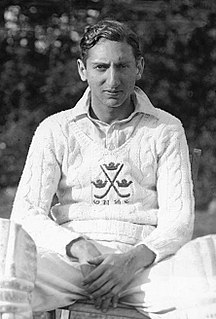
Nawab Mohammad Iftikhar Ali Khan Siddiqui Pataudi, sometimes I. A. K. Pataudi was the 8th Nawab of Pataudi and the captain of the India national cricket team for the tour to England in 1946. His son Mansoor, known as the Nawab of Pataudi Jr., also later served as captain of the India cricket team.
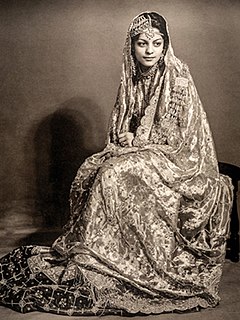
Sajida Sultan Ali Khan Pataudi was the daughter of the Nawab of Bhopal, Hamidullah Khan, and the begum of Iftikhar Ali Khan, 8th Nawab of Pataudi and, in her own right, the 12th Nawab Begum of Bhopal.
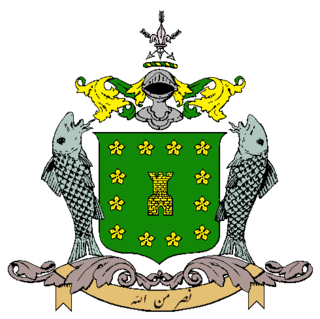
The Nawabs of Bhopal were the Muslim rulers of Bhopal, now part of Madhya Pradesh, India. The nawabs first ruled under the Mughal Empire from 1707 to 1737, under the Maratha Empire from 1737 to 1818, then under British rule from 1818 to 1947, and independently thereafter until it was acceded to the Union of India in 1949. The females nawabs of Bhopal held the title Nawab Begum of Bhopal.

Bhopal State was a tributary state in 18th-century India, a princely salute state with 19-gun salute in a subsidiary alliance with British India from 1818 to 1947, and an independent state from 1947 to 1949. Islamnagar was founded and served as the State's first capital, which was later shifted to the city of Bhopal.

Paigah is a family in the senior aristocracy of Hyderabad State, who were associated with ruling Nizam since its inception. and each maintained his own court, individual palaces, and a standing army of about fourteen thousand troops, both infantry and cavalry.

Major General Nawabzada Sher Ali Khan of Pataudi HJ was a Major General in Pakistan. Born into the Pataudi family, He was the second son of Nawab Ibrahim Ali Khan of Pataudi, in Pataudi and his wife Shahar Bano Begum, daughter of Amiruddin Ahmad Khan, the Nawab of Loharu.
Begum Noor Bano served as a Member of Parliament in the 11th Lok Sabha and 13th Lok Sabha, lower house of parliament of India. She was elected from Rampur on the ticket of Indian National Congress party.

Princess Suraya Jah, Nawab Gowhar-i-Taj, Abida Sultan Begum Sahiba was the eldest daughter of Hamidullah Khan, the last Nawab of the Bhopal state, and his wife Begum Maimoona Sultan.
Shahryar Mohammad Khan is a former career Pakistan diplomat who became Foreign Secretary of Pakistan in 1990, and remained so until his retirement from service in 1994. He later served as United Nations Special Representative of the Secretary-General to Rwanda (1994–1996), and wrote the book Shallow Graves of Rwanda on his experiences on what Rwanda went through. Since August 1999, he has intermittently served as the chairman of Pakistan Cricket Board, and also served as the president of Asian Cricket Council in 2016.
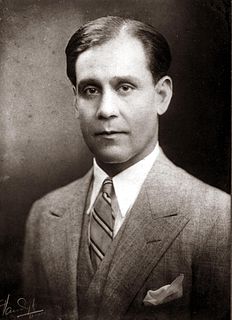
Hajji Nawab Hafiz Sir Hamidullah Khan was the last ruling Nawab of Bhopal, which merged with the state of Madhya Pradesh in 1956. He ruled from 1926 when his mother, Begum Kaikhusrau Jahan Begum, abdicated in his favor, until 1949 and held the honorific title until his death in 1960. A delegate to the Round Table Conference in London, he served as Chancellor of the Chamber of Princes from 1944–1947, when India became independent. During the Second World War, Nawab Hamidullah Khan was present at the Battle of Keren and the Battle of El Alamein. Nawab Hamidullah, as he was popularly known was very close to Muhammad Ali Jinnah, the founder of Pakistan. He also had very good terms with Louis Mountbatten, Viceroy and Governor General of India. In spite of pressure from Jinnah, he reluctantly agreed to have Bhopal as a part of Indian Union. At his death, he left no sons and so was succeeded by his second daughter, Sajida Sultan, Begum of Bhopal.
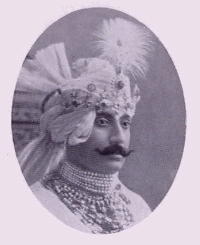
Sayyid Sir Wasif Ali Mirza Khan Bahadur was the Nawab of Murshidabad during 1906–1959. Sir Wasif Ali Mirza was educated at Sherborne School, Rugby School and later at Trinity College. He succeeded his father Hassan Ali Mirza Khan Bahadur at his death on 25 December 1906. On 11 December 1931, Wasif Ali was forced to surrender the administration of his estates to the Government of India after incurring a debt of ₹19 lakhs. On 15 August 1947, the Radcliffe Award allotted the district of Murshidabad to Pakistan and the Flag of Pakistan was hoisted at the Hazarduari Palace but within two days the two dominions exchanged Khulna, which is now in Bangladesh, and then the Flag of India was hoisted at the grand palace on 17 August 1947. The Government of India also resumed him all his estates in 1953. Wasif Ali was also the founder and president of the Hindu-Muslim Unity Association in the year 1937, named Anjuman-e-Musalman-e-Bangla, which promoted Hindu-Muslim unity. The Nawab also built the Wasif Manzil.
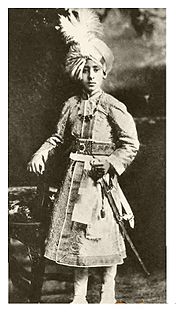
Sayyid Waris Ali Mirza Khan Bahadur was the last Nawab of Murshidabad before a prolonged interregnum caused by a succession dispute within the family that was only resolved in 2014 by the Indian Supreme Court. He succeeded his father, Wasif Ali Mirza.
Nawab Sayyid Murtaza Ali Khan Bahadur, MBE was the titular Nawab of Rampur from 1966 to his death in 1982, succeeding his father, Nawab Raza Ali Khan Bahadur. Murtaza was succeeded by his younger brother Zulfikar Ali Khan Bahadur.
Nawab Sayyid Muhammad Sharif Ali Khan Bahadur is an Indian politician and was a member of the 16th Legislative Assembly of Uttar Pradesh of India. Muhammad Kazim Ali served as an MLA in the Swar Tanda Uttar Pradesh state assembly; in 2003 he was briefly the state minister for Minority Welfare and Hajj Affairs. Since 2003, he has been the Chairman of the Uttar Pradesh Tourism Development Corporation.

Hajjah Nawab Begum Dame Sultan Jahan was a notable and progressive Begum of Bhopal who ruled from 1901 to 1926.

Nawab Mohammad Mansoor Ali Khan Siddiqui Pataudi, was an Indian cricketer and former captain of the Indian cricket team. He was the titular Nawab of Pataudi from 1952 until 1971, when by the 26th Amendment to the Constitution of India the privy purses of the princes were abolished and official recognition of their titles came to an end.
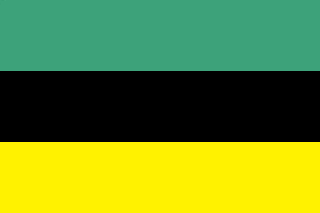
Kurwai State was a princely state of British India under the Bhopal Agency and centered on Kurwai town. The town of Kurwai was founded by Mohammed Diler Khan in 1715. The state was 368 km² in area and had a population of 30,631 in 1892.
Saad Bin Jung is a former Indian cricketer who played first-class cricket from 1978 to 1984. He is now a conservationist and author and runs the Royal Migration Camps in the Serengeti in Tanzania whilst his children manage The Bison in South India.
Saba Ali Khan is a jewelry designer and mutawalli of the Auqaf-e-Shahi established by the princely state of Bhopal as a royal charitable endowment.
Turkish people in India are very small in number, and are recent immigrants from Turkey. In the 1961 census, 58 people stated that their mother tongue was Turkish. According to the 2001 census, 126 residents of India stated their place of birth as Turkey. In a state visit during early 2010, Prime Minister Abdullah Gül of Turkey met Turkish expatriates living in India and handed out Hindi–Turkish dictionaries to Turkish students in New Delhi.
References
- ↑ Jhala, p. 74
- ↑ Jhala, p. 70-71
- 1 2 3 Jhala, p. 71-72
- ↑ Jhala, p. 73
- 1 2 3 4 "How rich is the Nawab?". India Legal Online. 26 May 2015. Retrieved 24 September 2016.
- ↑ "Kareena Kapoor Khan, Saif Ali Khan blessed with a baby boy, name him Taimur". The Indian Express. 20 December 2016. Retrieved 20 December 2016.
- Jhala, Angma Dey (2008). Courtly Indian Women in Late Imperial India. Routledge. ISBN 978-1851969418